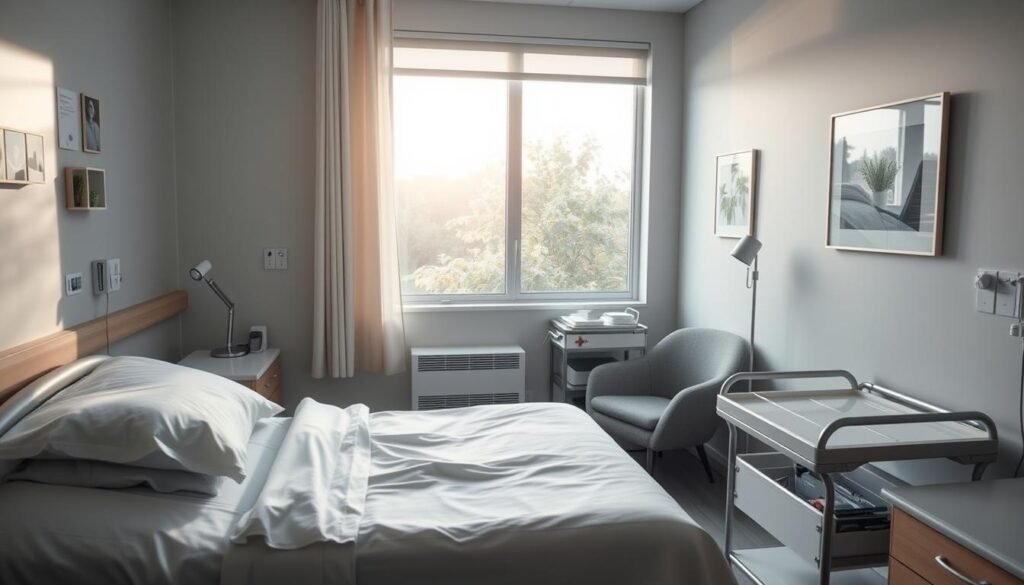Depression ranks as the second most disabling condition worldwide. Experts believe it might take the top spot by 2030. About 4% of people in the U.S. deal with Major Depressive Disorder (MDD) each year. Knowing how to tackle Treatment Options for Major Depressive Disorder (MDD) is key. This condition doesn’t just affect personal health. It’s also linked to a higher chance of suicide and early death.
Starting recovery usually involves a detailed assessment. This helps pick the best treatment plan. Choices may include drugs, talking therapies, lifestyle shifts, or a mix of these. SSRIs are often the first choice to fight depression’s intense periods. Therapies like cognitive behavioral therapy work on changing negative thoughts and improving relationships.
It’s vital to catch depression early. Symptoms can drag on for a long time without help. So, learning about treatment options is a critical step toward getting better. For more detailed info on handling this disorder, check the Mayo Clinic.
Key Takeaways
- Depression is expected to become the leading cause of disability by 2030.
- Selective serotonin reuptake inhibitors (SSRIs) are a common treatment for MDD.
- Around 4% of the U.S. population suffers from MDD each year.
- Psychotherapy options like cognitive behavioral therapy can aid in treatment.
- Combining treatments often provides an integrated approach to managing depression.
- Without treatment, MDD symptoms can linger for extended periods, highlighting urgency.
Understanding Major Depressive Disorder (MDD)
Major Depressive Disorder is a serious mental health issue that deeply affects daily living. It impacts about one in six people at some point in their lives. In 2021, more than 8% of U.S. adults had a major depressive episode, showing how common it is.
To diagnose this disorder, one must meet certain criteria from the DSM-5. Symptoms include lasting sadness or disinterest in usual activities, sleep problems, appetite changes, feeling worthless, and sometimes thoughts of death or suicide. Recognizing these signs is key for anyone thinking about their mental health and looking for help. For more details on diagnosis, check this resource.
MDD affects mental, physical, and behavioral health in many ways. People may feel emotionally upset, but also have physical issues like fatigue and headaches. Various things, like stressful events or substance use, can trigger MDD.
Treating Major Depressive Disorder usually involves a mix of therapies, medication, and lifestyle adjustments. Psychotherapy, such as cognitive behavioral therapy, helps many manage their negative thoughts and improve coping methods. Improving sleep and exercising more are good first steps in combating depression. This link gives more information on understanding and dealing with MDD.
Understanding MDD helps people seek help in time. This can empower them to improve their mental health and enjoy life again.
Symptoms of Major Depressive Disorder
The Symptoms of MDD appear in different ways, important for a correct diagnosis. To match the Diagnostic Criteria for major depressive disorder, at least five symptoms are needed. One must be a sad mood or loss of interest for at least two weeks.
Common Mental Health Symptoms of MDD are:
- Persistent sad or anxious mood
- Feelings of hopelessness or guilt
- Changes in weight or appetite
- Fatigue or decreased energy
- Difficulty concentrating or making decisions
- Sleep disturbances
- Thoughts of death or suicide
It’s key for people and their loved ones to recognize these signs. This could point to the need for professional aid. Depression can badly affect daily life and bring immense distress. Note, symptoms can vary, with men often showing irritability.
Some symptoms may turn into different depressive disorders. These include persistent depressive disorder or perinatal depression. Individuals with signs of depression for two years might have persistent depressive disorder. Perinatal depression happens during or after pregnancy. Seasonal affective disorder starts in fall or winter.
Knowing the Symptoms of MDD leads to seeking help and finding treatments. This is key for recovery and good health.
Importance of Seeking Treatment
Understanding how crucial treatment is for Major Depressive Disorder (MDD) is vital. People with depression face big challenges that hurt their life quality, functionality, and happiness. Without treatment, depression gets worse, leading to more hopelessness and a higher suicide risk. Getting help early is key to reducing these risks and improving mood and daily life.
Seeking Mental Health Treatment brings big benefits. Most people who get treatment feel much better emotionally. They also act in healthier ways. Having strong support is key. Talking to doctors and loved ones helps, making the treatment process work better by sharing symptoms and adjusting care as needed.
It’s key to know that some groups, like women and LGBTQI+ people, may have higher depression rates. Men might not recognize or seek help for their emotional issues. This leads to cases that are not diagnosed or treated. It shows why it’s important to tailor treatment to different groups and personal situations.
Handling Depression well means noticing signs and symptoms early. Feeling sad a lot, eating differently, and being more irritable are signs to get help. Stressing treatment’s importance helps people not to suffer alone. It clears the way to recovery.
Treatment Options for Major Depressive Disorder (MDD)
Treatment options for MDD vary to suit individual needs. Managing depression often involves drugs, therapy, lifestyle changes, and sometimes, brain stimulation. Knowing about these methods helps people choose their recovery path.
Overview of Treatment Methodologies
Many methods effectively manage MDD. Drugs are crucial for many people. Antidepressants, like SSRIs and SNRIs, are important in serious cases. Along with medicines, therapy methods such as CBT and interpersonal therapy support those with depression.
- Antidepressant medications are a key Treatment Options for MDD, easing symptoms for many.
- Psychotherapy gives vital coping and understanding strategies for depression’s emotional challenges.
- Lifestyle changes, like more exercise and socializing, are crucial for overall health.
- In cases where usual treatments don’t work, rTMS and ketamine therapies can help a lot.
Initial Assessment and Diagnosis
To treat MDD right, a detailed Assessment and Diagnosis are needed. Doctors usually do physical exams, lab tests, and mental health checks. This broad approach helps create a custom treatment plan.
Important steps in the assessment include:
- Looking at medical history to find any other health issues.
- Checking symptoms like mood swings and energy levels.
- Psychiatric evaluations to diagnose MDD and spot other mental disorders.

Understanding MDD improves talks between patients and doctors, leading to better Medication Management and treatment results.
Pharmacotherapy: Antidepressants
Pharmacotherapy is a key way to treat Major Depressive Disorder (MDD). Antidepressants are often chosen for treatment. It’s important to know the types of antidepressants available. This helps patients and doctors make choices that are right for each person.
Types of Antidepressants
There are many kinds of antidepressants. Each works differently in the brain. They help reduce the symptoms of depression. Here are the types:
- Selective Serotonin Reuptake Inhibitors (SSRIs): These are common choices like fluoxetine (Prozac) and sertraline (Zoloft). They mainly increase serotonin. This can lead to a better mood.
- Serotonin-Norepinephrine Reuptake Inhibitors (SNRIs): Drugs such as venlafaxine (Effexor) and duloxetine (Cymbalta) work on serotonin and norepinephrine. They are good for severe symptoms.
- Atypical Antidepressants: This group, including mirtazapine (Remeron) and bupropion (Wellbutrin), works in different ways. They are chosen based on a patient’s history.
- Tricyclic Antidepressants: Used less often today because of side effects. Drugs like amitriptyline are options when others don’t work.
- Monoamine Oxidase Inhibitors (MAOIs): These are for hard-to-treat cases. They can affect what foods you can eat and need careful diet management.
How They Work
Antidepressants change the levels of neurotransmitters in the brain. This aims to improve mood and how a person functions. For many, medication management means closely watching the effects since reactions vary. While those with severe depression often benefit a lot, those with milder forms may see less change.
A treatment often lasts at least six months. This helps patients reach a level of recovery they are happy with. Combining drugs with therapy can help even more, especially with long-term mood issues. Talking about possible side effects with a doctor is vital. It ensures the support fits the patient’s needs.
Psychotherapy Options for MDD
Psychotherapy is key in treating Major Depressive Disorder (MDD). It offers different ways to deal with symptoms. It can teach how to change negative thinking, improve relationships, and find personal coping strategies. Many adults find regular therapy sessions greatly benefit their mental health.
Different Forms of Psychotherapy
There are many types of psychotherapy for MDD. Three main ones are Cognitive Behavioral Therapy (CBT), Interpersonal Therapy (IPT), and problem-solving therapy. Each one has its own way of helping and suits different people’s needs.
- Cognitive Behavioral Therapy (CBT): CBT deals with negative thought patterns. It builds skills to manage symptoms. Adults usually have 20-24 sessions over weeks.
- Interpersonal Therapy (IPT): IPT focuses on relationships and social skills. It works on improving how we communicate and respond emotionally. Typically, it involves 16 to 20 sessions.
- Problem-solving Therapy: This therapy helps tackle specific problems. It aims to boost problem-solving abilities and resilience against depression.
Depressive disorders lead to disability across the globe, ranking 13th. With a 12 percent lifetime prevalence, the role of psychotherapy is clear. Over 40 percent might face another depressive episode within two years, highlighting the importance of therapy.

Finding a good therapist and the right approach can make a big difference in fighting MDD.
| Type of Therapy | Focus Area | Average Sessions |
|---|---|---|
| Cognitive Behavioral Therapy (CBT) | Negative thought patterns | 20-24 weekly sessions |
| Interpersonal Therapy (IPT) | Interpersonal relationships | 16-20 weekly sessions |
| Problem-solving Therapy | Structured problem-solving | Varies |
Brain Stimulation Therapies
Brain stimulation therapies are helpful for people with hard-to-treat depression. They affect brain activity and chemistry to provide relief when normal methods don’t work. Electroconvulsive Therapy (ECT) and Repetitive Transcranial Magnetic Stimulation (rTMS) are key therapies. They have different processes, benefits, and risks to fit patient needs.
What Are Brain Stimulation Therapies?
ECT is a well-known form of brain stimulation for severe depression. The FDA approves it when other treatments fail. It uses electrical currents to spark the brain, often improving mood significantly.
rTMS, on the other hand, is noninvasive and uses magnetic fields. It’s FDA-approved for major depression and helpful for conditions like OCD and migraines. Patients go through multiple sessions over several weeks. Most see symptom improvements slowly, backed by ongoing research.
These therapies have different side effects. rTMS might cause scalp discomfort and slight headaches. ECT can lead to memory issues and confusion, especially the older methods. But, new techniques are reducing these problems.
In conclusion, therapies like ECT and rTMS are new chances for those who haven’t benefitted from standard treatments. Ongoing studies are making them safer and more effective. For more details on these therapies, visit this resource.
Lifestyle Changes for Managing MDD
Making meaningful lifestyle changes is key to managing Major Depressive Disorder (MDD). These steps can improve your overall well-being. They also help your mental health. Regular exercise is crucial. Try moderate exercise for 30 minutes a day, three to five times a week. It can lift your mood, raise your self-esteem, and help you sleep better.
Eating well is also important for your mind. Studies show that more magnesium, folic acid, and vitamin B can make you feel happier. Eating foods high in branched-chain amino acids (BCAAs) might reduce depression and anxiety. But, more research is needed. Eating right and exercising can make you stronger against stress.
Good sleep habits are vital when making lifestyle changes. A relaxing bedtime routine and a consistent sleep schedule can help. It improves how well and how much you sleep when you’re depressed.
Having a strong support network is crucial. Good relationships provide emotional support, which is key when dealing with MDD. Spending time with friends or family can help you heal.
Managing stress is important too. Relax by watching movies, reading, or practicing mindfulness. These activities can lower stress and its effects on your health. Adding them to your daily routine can improve your ability to cope and make you emotionally stronger.
| Lifestyle Changes | Benefits |
|---|---|
| Regular Physical Activity | Boosts mood, improves self-esteem, enhances sleep quality |
| Balanced Diet | Contributes to mood improvement, supports overall health |
| Consistent Sleep Schedule | Improves sleep quality, enhances mental clarity |
| Strong Support Network | Provides emotional support, aids in coping with challenges |
| Stress Management Techniques | Alleviates the impact of stress on depression, promotes relaxation |
Alternative Therapies to Consider
Depression treatment now includes different options, known as alternative therapies. These can work well with usual treatments. They help improve a person’s wellbeing. Various methods offer unique benefits.
St. John’s wort is often used for mild depression. It has less effect on severe depression. Supplements like 5-HTP and SAMe are under review for depression relief. Meditation helps with stress, boosting mental health.
Yoga could assist with depression, but proof is still needed. Touch therapies, which focus on the mind and body, promote better health. Exercises that engage the body and mind bring peace.
Exercise fights depression by lowering stress. Music therapy reduces fear and anxiety. It has also supported veterans since World War II.
Some people don’t get better with regular depression meds. But TMS therapy shows improvement in most patients. It works quicker, with results seen in two weeks.
Below is a summary table that outlines various alternative therapies for depression management along with their potential benefits:
| Alternative Therapy | Potential Benefits |
|---|---|
| St. John’s Wort | May help with mild to moderate symptoms |
| 5-HTP and SAMe | Studied for their antidepressant effects |
| Meditation | Aids relaxation and stress relief |
| Yoga | Evidence suggests potential assistance in managing symptoms |
| Touch Therapy | Enhances mind-body connection for better health |
| Exercise | Lower stress levels and mitigate symptoms |
| Music Therapy | Helps ease anxiety and promotes emotional healing |
Inpatient Treatment for Severe Cases
Inpatient treatment is key for those with severe depression. It provides the fullest level of care. Those who are really struggling need close watch and regular therapy. They often stay at the center for days to months. This time helps them stabilize and start to recover.

This care includes many therapies for mental health and other issues. Patients are in a safe place with 24/7 support. They get help with meds and join in many healing activities. It’s for those who can’t be safe at home or might hurt themselves. Being inpatient helps them heal with expert care.
There, people do group therapy. They share stories and learn together. This breaks the loneliness that comes with deep depression. When leaving, they get a plan for more care, moving to outpatient treatment. This helps them keep recovering over time.
Insurance is important for getting into these programs. Most insurance covers it, but check your plan for details. The cost depends on the center. Fancy places may cost more but not be better in care.
Inpatient care is crucial for those facing dark times with depression. It offers a safe spot to find hope again. If you’re thinking about it, know how it helps. Understanding inpatient care is key for mental health. For more on when it’s needed, check this resource.
Combination Treatments: An Integrated Approach
Managing major depressive disorder (MDD) often involves more than one type of treatment. Research shows that only about a third of patients get fully better with just one treatment method. This makes it clear that Combination Treatments are needed. They combine different ways of treatment to get better results.
The Integrated Approach combines drugs for depression and talking therapies. This mix has been proven to not just help people get better, but also to stay better for longer. For some groups like older people or women, mixing treatments works especially well, being more effective than just one treatment.
Science says that using drugs and therapy together works better than using each alone. Even so, many patients are treated by different doctors, which can make it hard to coordinate care. This lack of coordination can lessen the benefits of combined treatments.
It can be tricky to figure out the best way and time to use combination treatments. Things like when doctors are available and how treatments are paid for can make it hard to provide care where therapists and doctors work together closely.
Putting an emphasis on Combination Treatments shows the need for a personal approach in treating depression. This means looking closely at each patient’s situation to find the most effective way to manage major depressive disorder.
| Aspect | Single Modality Treatment | Combination Treatment |
|---|---|---|
| Full Remission Rate | ~33% | Higher than single modalities |
| Risk of Relapse | Higher | Lower |
| Best Populations | N/A | Elderly, Women |
| Care Coordination | Less frequent | Often requires coordinated care |
Conclusion
Treatment options for Major Depressive Disorder (MDD) vary based on personal needs. Around 300 million people worldwide are dealing with MDD. It’s crucial for anyone with symptoms to know how to manage them. Treatments include drugs, therapy, and changes in lifestyle.
Working with healthcare providers is key to finding the best treatment. Recovery from mental health issues is truly possible with proper support. Knowing that over half of the patients got treatment last year shows the importance of seeking help early.
A holistic approach to MDD can bring hope to many. Combining treatments often leads to better recovery. Getting help is the starting point towards a brighter future for those struggling.